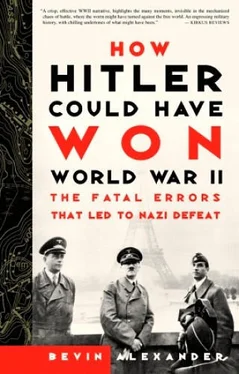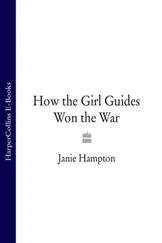Virtually the entire American sector—from the coast of the Cotentin to the line Caumont-Bayeux—was bocage country. In the British sector to the east the land was part bocage and part rolling countryside punctuated by hamlets and small woods. For centuries Norman farmers had enclosed their land in small fields by raising embankments three or four feet high. These banks were overgrown with dense shrubbery, brambles, hawthorn, and small trees. The hedgerows were intended as fences to hold livestock, mark boundaries, and protect animals and crops from sea winds. Each field had a gate to admit animals and equipment. Dirt tracks or sunken lanes ran between these hedgerows, permitting troops and weapons to move free from observation from the air or on the ground. The effect was to divide the terrain into thousands of walled enclosures.
The bocage proved to be ideal country for the Germans to defend. Antitank weapons —Panzerfäuste, or bazooka rocket tubes—and machine guns posted in the hedgerows could remain hidden until a tank was within fifty yards, destroy all but the heaviest tank with one shot, and stop the advance of infantry. In addition, tanks, assault guns, and 88-millimeter antiaircraft guns concealed in the bocage or villages could knock out any Allied tank up to 2,000 yards distant.
The Germans organized each field (mostly seven to fifteen acres) as a defensive stronghold, posting machine guns in the corners to pin down Americans advancing across in the open. They placed other automatic weapons in the hedgerows on the front and flanks of the attackers. Once they had stopped the attack, the Germans brought down preregistered mortar rounds on the field. Mortars caused three-quarters of American casualties in Normandy.
American artillery fire could not be used often, since the range was so close that rounds might land on Americans. This undermined the standard American method of fighting. Infantry habitually maneuvered to locate the enemy, then called on artillery to finish him off. Green infantry tended not to move at all under fire, but to seek the nearest cover or hug the ground.
The hedgerows also nullified the tanks’ greatest advantages, mobility and firepower. Tankers were reluctant to operate within the confined spaces of the bocage, yet if they stayed on the main roads or lanes they made excellent targets. Commanders realized tanks had to get off the roads, but this forced them into the hedgerows.
Some way had to be found to break the impasse. Normal American practice had been for tanks and infantry to advance in separate echelons. In Normandy, astute commanders realized the two had to work together (thus recognizing at long last the Kampfgruppe system the Germans had perfected since 1940).
The 29th Infantry Division’s method was one of the best. Developed in June and tested on July 11 east of St.-Lô, the 29th’s system consisted of a four-phase operation. First, a Sherman M4A3 medium tank broke through enough vegetation in the center of a hedgerow to allow its cannon and machine gun to open up against the enemy-held hedgerow on the opposite side of the field. Meanwhile a 60-millimeter mortar crew lobbed shells behind the enemy hedgerow. Under intense covering fire of the tank’s machine gun, a squad of infantry advanced in open formation across the field. As they closed on the enemy, the infantry tossed hand grenades over the hedgerow to kill or confuse the German defenders. Meanwhile, the Sherman tank backed away from its firing position, and an engineer team blew a hole in the hedgerow for the tank to drive through. The tank then rushed forward to assist the infantry in flushing any remaining enemy soldiers out of the hedgerow.
Although this and similar systems worked, the process was slow. Others were thinking of a faster and safer way to get Shermans through the hedgerows—since crashing through exposed the thin underside of the tanks to enemy fire.
Shermans equipped with bulldozer blades could do the job, but there were few such equipped tanks in the theater. Using explosives to break a hole in the hedgerow gave away the attack and served as an aiming point for German weapons. At last, individual soldiers came up with welded devices on the front of Shermans that could crack through the thickest hedgerow. In a prodigious effort, 1st Army welding teams produced 500 hedgerow cutters between July 14 and 25. By late July 60 percent of the army’s Shermans were equipped with the device.
Bradley, stymied by fierce German defense of the hedgerows, conceived a new plan of attack, which he named Cobra. He decided to focus the breakout around St.-Lô, spearheaded by Lawton Collins’s 7th Corps. The key feature would be a massive air attack on the narrow front. When Collins broke through, the whole weight of 1st Army, now fifteen divisions, would be thrown into the assault.
Meanwhile Montgomery drew up plans for an offensive at Caen, code-named Goodwood, to support Cobra. Montgomery launched Goodwood on July 18, preceded by a massive air attack by 1,700 heavy and 400 medium bombers. At first the British attack went well. Tanks advanced against the stunned German defenders. But bomb craters slowed the armor, and the Germans pulled themselves together and launched a counterattack. It gained no ground, but inflicted heavy losses on the British. On July 20, Montgomery called off the attack, having moved six miles south of Caen, but having lost 4,000 men and 500 tanks.
Bradley’s Cobra plan was risky because aviators were not skilled in pinpoint strikes, and the operation called for saturation bombing of a rectangle three miles wide and one mile deep south of the east-west St.-Lô–Périers road. An error would bring bombs down on American troops.
Bradley did not want the aircraft to fly over American lines, and proposed that the planes approach on a course parallel to the St.-Lô–Périers road. On July 19 Bradley flew back to England to discuss the operation with top air commanders. They opposed a parallel approach, saying aircraft would be exposed longer to enemy antiaircraft fire and the approach would require hitting a one-mile-wide target, whereas a perpendicular approach would present a three-mile-wide target. But by the time he left, Bradley thought he had got their agreement. To minimize the chances of American troops being hit, Bradley withdrew them 1,500 yards north of the road.
Heavy rains caused postponement of Cobra until July 24. Cloud cover forced cancellation this day as well, but not before 400 bombers reached France and let go their bombs. To Bradley’s horror, the bombers approached perpendicular to the American lines, not parallel. Many bombs fell on American positions, killing 25 and wounding 131. When Bradley complained, the air force brass claimed they had never agreed to a parallel approach. And they told Bradley they would not mount a second attack except in the same direction.
Bradley, having no choice, agreed, and the air assault went in on July 25: 1,500 heavy bombers, 380 medium bombers, and 550 fighter-bombers dropped 4,000 tons of bombs and napalm. Once more “shorts” caused American casualties, 111 dead, 490 wounded.
Collins threw 7th Corps’s three divisions into the blasted terrain that the bombers had created. The Americans expected the Germans to be dazed and unable to fight. Instead, they met heavy resistance. Eisenhower, who had observed the bombings, flew back to England dejected, determined never again to use heavy bombers to support ground forces.
Despite the bitter resistance of a few Germans, the bombing had done great damage. Fritz Bayerlein, commanding Panzer Lehr Division, which received the brunt of the attack, wrote: “Units holding the front were almost completely wiped out.” Tanks were overturned, artillery shattered, infantry positions flattened, and all roads destroyed. By midday the landscape resembled the moon. “There was no hope of getting out any of our weapons,” Bayerlein wrote. “The shock effect was indescribable. Several of the men went mad and rushed dementedly around in the open until they were cut down by splinters.”
Читать дальше


![Джонатан Димблби - Barbarossa - How Hitler Lost the War [calibre]](/books/385421/dzhonatan-dimblbi-barbarossa-how-hitler-lost-the-w-thumb.webp)









